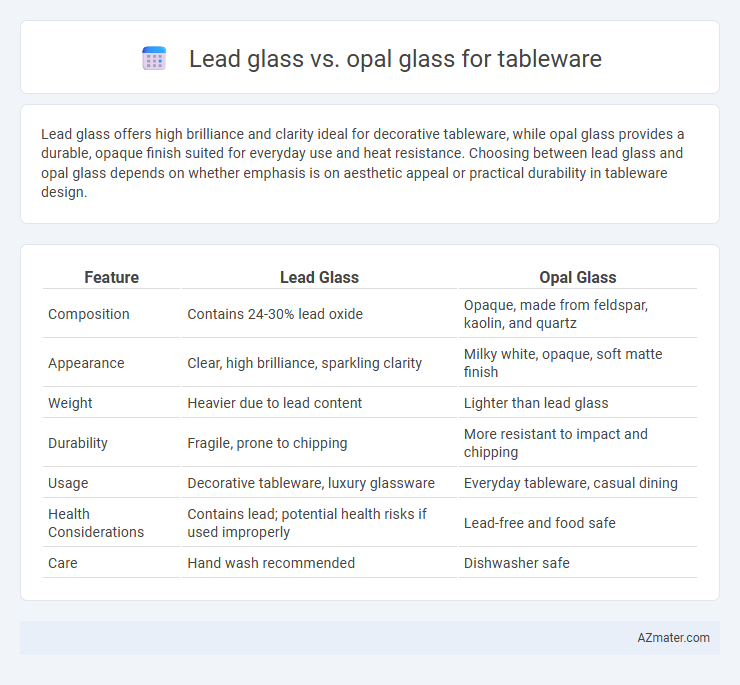Lead glass offers high brilliance and clarity ideal for decorative tableware, while opal glass provides a durable, opaque finish suited for everyday use and heat resistance. Choosing between lead glass and opal glass depends on whether emphasis is on aesthetic appeal or practical durability in tableware design.
Table of Comparison
| Feature | Lead Glass | Opal Glass |
|---|---|---|
| Composition | Contains 24-30% lead oxide | Opaque, made from feldspar, kaolin, and quartz |
| Appearance | Clear, high brilliance, sparkling clarity | Milky white, opaque, soft matte finish |
| Weight | Heavier due to lead content | Lighter than lead glass |
| Durability | Fragile, prone to chipping | More resistant to impact and chipping |
| Usage | Decorative tableware, luxury glassware | Everyday tableware, casual dining |
| Health Considerations | Contains lead; potential health risks if used improperly | Lead-free and food safe |
| Care | Hand wash recommended | Dishwasher safe |
Overview of Lead Glass and Opal Glass
Lead glass, known for its high refractive index and clarity, contains lead oxide which enhances brilliance and weight, making it ideal for luxury tableware such as fine glassware and crystal bowls. Opal glass, a type of translucent white glass created by adding opacifiers like tin oxide or fluorides, offers a smooth, matte finish that resists staining and provides a more casual and durable option suitable for everyday tableware. Both materials differ significantly in composition and aesthetic appeal, with lead glass prized for elegance and opal glass valued for practicality.
Composition and Material Differences
Lead glass contains 18-40% lead oxide, enhancing its refractive index and giving it a brilliant, sparkling appearance ideal for decorative tableware. Opal glass is made from borosilicate with added opacifiers like bone ash or tin oxide, resulting in a milky, translucent finish prized for its durability and resistance to thermal shock. The key material difference lies in lead glass's heavy metal content boosting brilliance versus opal glass's silica-based formulation providing a distinctive opaque aesthetic and robust performance.
Visual Appearance and Aesthetics
Lead glass offers superior clarity and brilliance due to its high refractive index, creating a sparkling effect that enhances the visual appeal of tableware. Opal glass, with its milky, translucent finish, provides a unique soft glow and a matte aesthetic that suits contemporary and vintage styles alike. Both materials contribute distinct elegance to table settings, with lead glass emphasizing shine and transparency, and opal glass highlighting muted sophistication and subtle texture.
Durability and Strength Comparison
Lead glass tableware exhibits higher durability due to its increased density and resistance to chipping compared to opal glass, which is more prone to surface scratches and breakage. Opal glass, while aesthetically pleasing with its opaque, milky finish, lacks the structural strength found in lead glass, making it less ideal for everyday use where impact resistance is crucial. The lead content in lead glass enhances its toughness, resulting in longer-lasting tableware suitable for frequent handling and washing.
Safety and Health Considerations
Lead glass tableware contains lead oxide, which can leach into food and beverages, posing health risks such as lead poisoning with prolonged exposure. Opal glass is lead-free and made from a fusion of soda-lime glass and feldspar, making it a safer choice for everyday use due to its non-toxic composition. The non-porous surface of opal glass also resists stains and bacterial growth, enhancing hygiene compared to lead glass.
Weight and Handling Characteristics
Lead glass tableware is generally heavier due to its high density, providing a substantial and luxurious feel, which can enhance the perceived quality but may require more careful handling. Opal glass is lighter and more durable, making it easier to handle and less prone to accidental breakage during daily use or transport. Choosing between lead glass and opal glass depends on whether weight and a premium tactile experience or ease of handling and practicality are prioritized.
Price and Market Availability
Lead glass tableware generally commands a higher price due to its enhanced brilliance and weight, making it a premium choice in luxury markets. Opal glass offers a more affordable alternative, characterized by its opaque, milky appearance and widespread availability in mass-market tableware collections. Market availability for lead glass is more limited and specialized, whereas opal glass is extensively produced and distributed, catering to budget-conscious consumers.
Suitability for Everyday Use
Lead glass tableware offers superior clarity and elegance, making it ideal for special occasions but its weight and fragility limit everyday practicality. Opal glass provides excellent durability and resistance to thermal shock, ensuring it withstands frequent use, washing, and handling without chipping or cracking. Its opaque finish also resists staining and maintains aesthetic appeal over time, making opal glass more suitable for daily tableware.
Environmental Impact and Sustainability
Lead glass contains lead oxide, which poses significant environmental hazards during production and disposal due to lead's toxicity and potential to contaminate soil and water. Opal glass, often made from silica and other non-toxic materials, offers a more sustainable alternative with a lower ecological footprint and safer recycling processes. Choosing opal glass tableware reduces harmful environmental impact and supports sustainability goals through safer materials and cleaner manufacturing practices.
Choosing the Right Glass for Your Tableware
Lead glass offers exceptional clarity and brilliance, making it ideal for elegant tableware that showcases intricate designs and enhances the visual appeal of beverages. Opal glass provides a durable, opaque finish that resists staining and scratches, perfect for everyday use and items requiring a classic, matte aesthetic. Selecting between lead glass and opal glass depends on balancing the desire for luxury and shine against durability and maintenance requirements for your specific tableware needs.

Infographic: Lead glass vs Opal glass for Tableware
 azmater.com
azmater.com